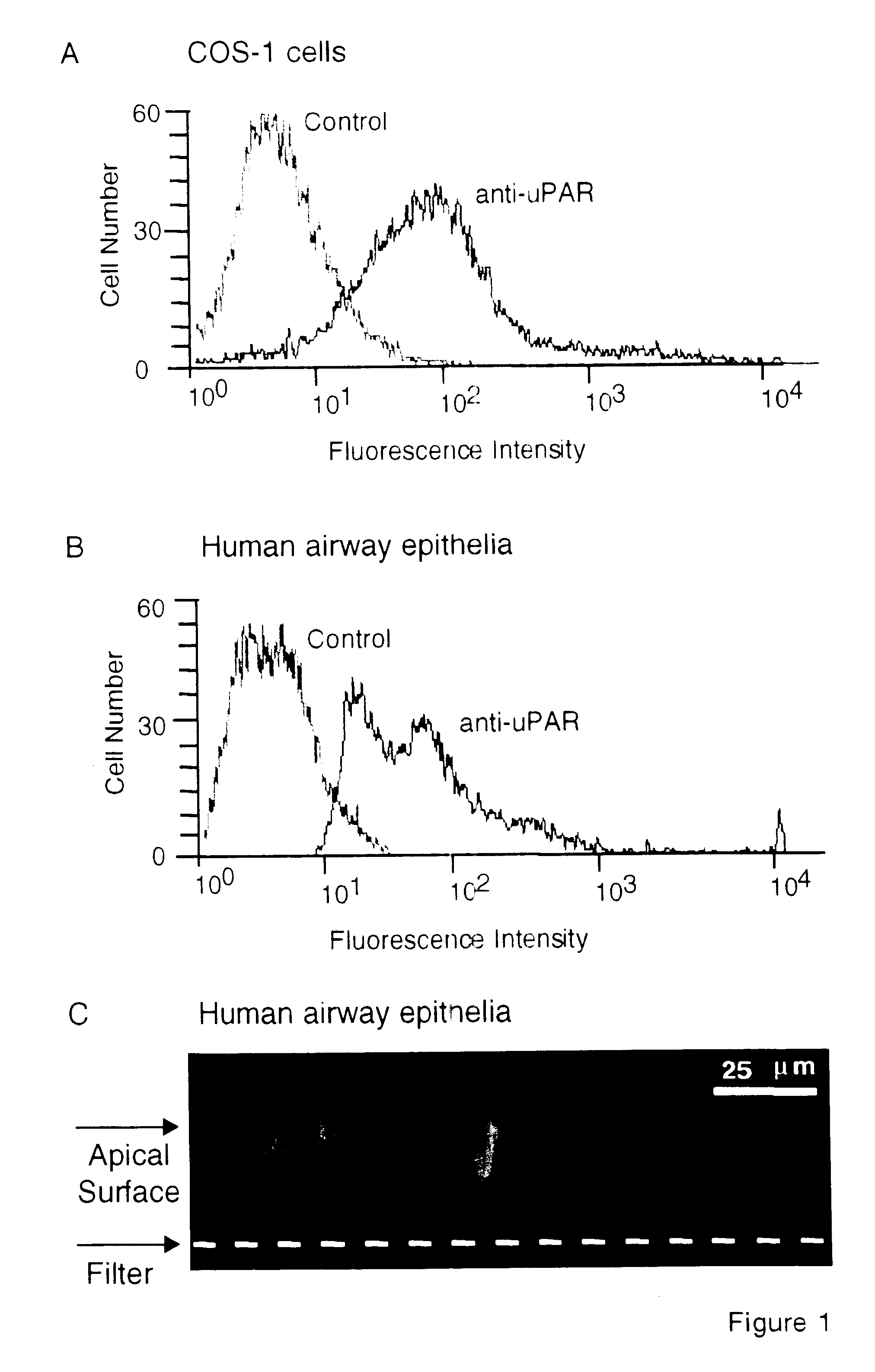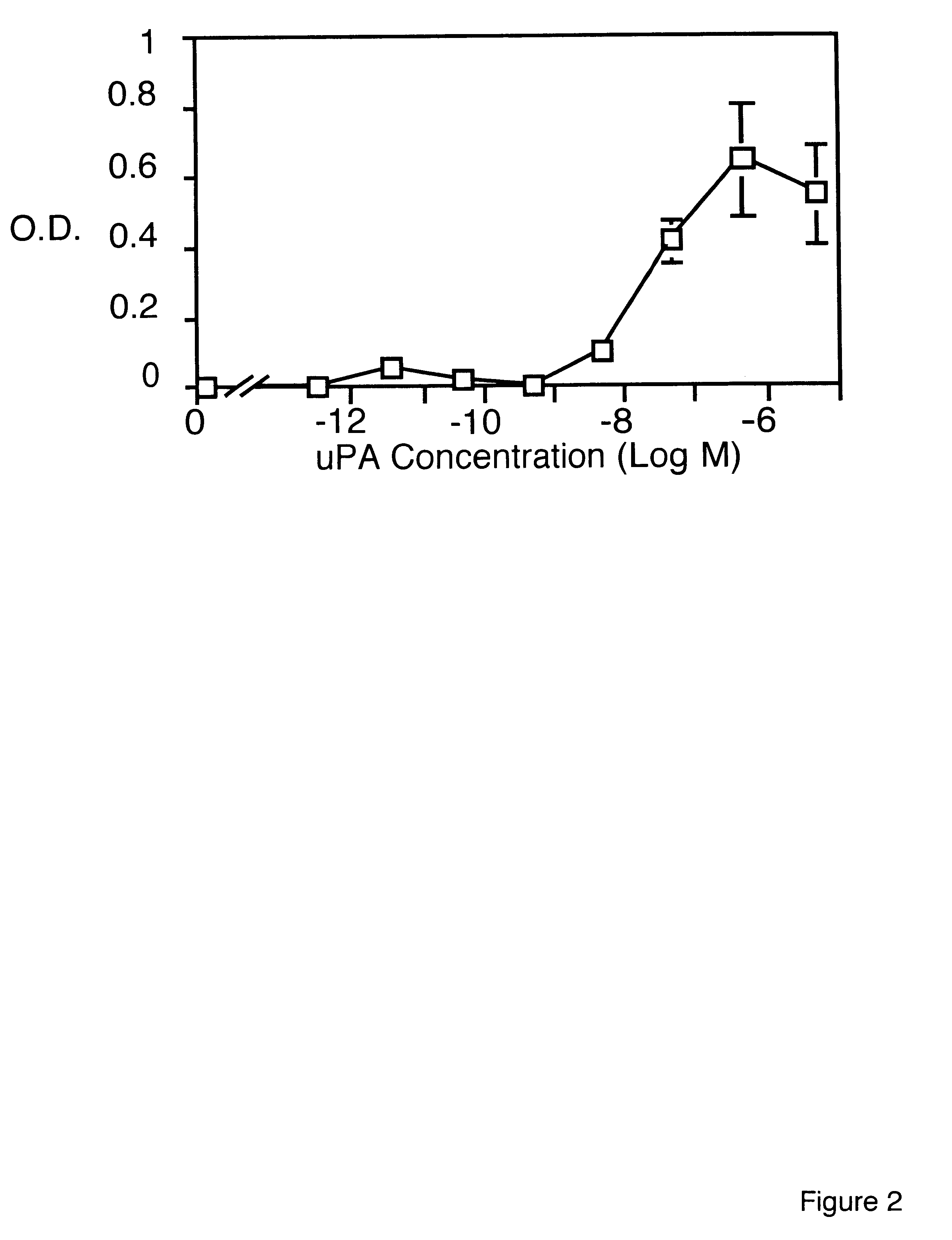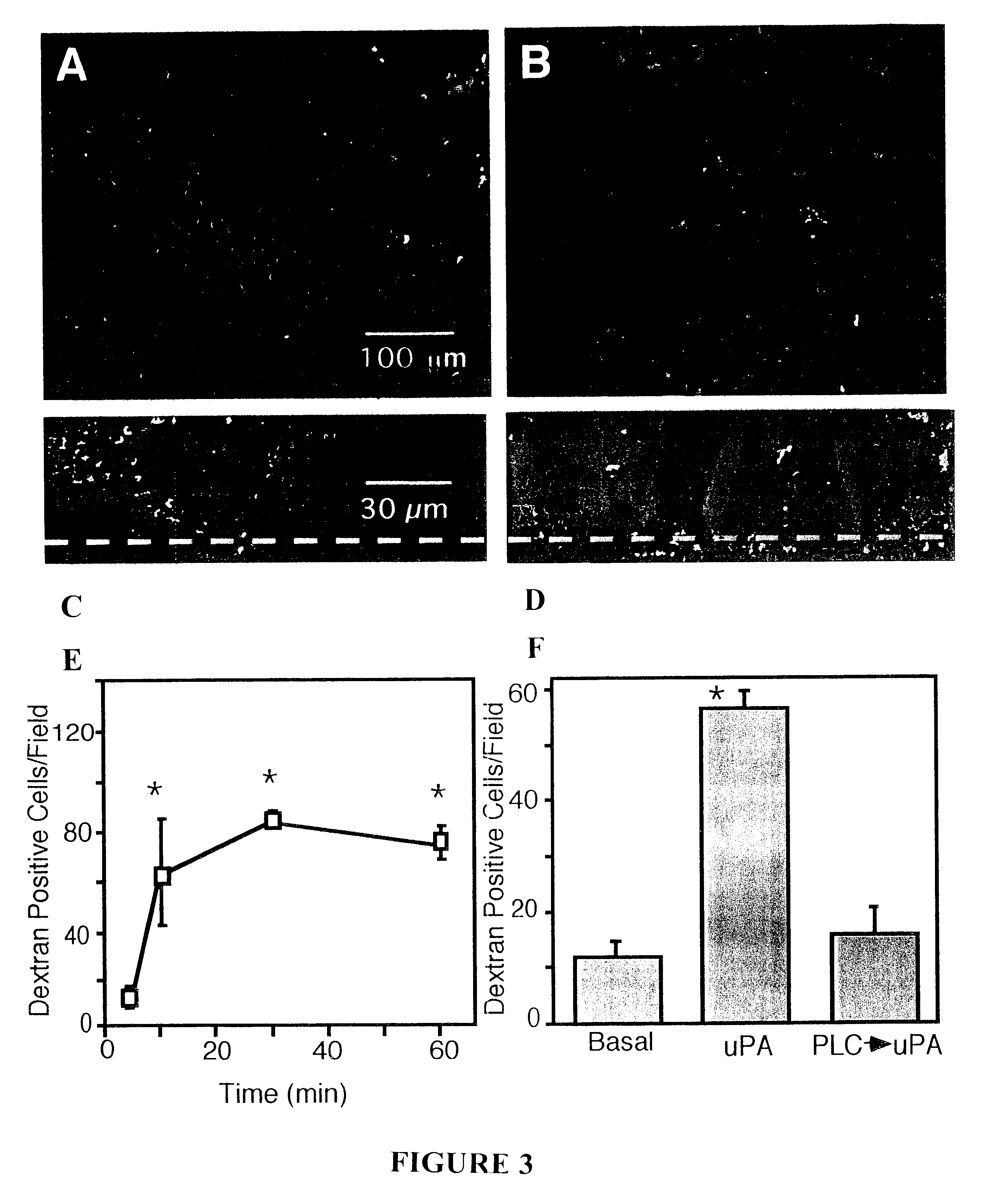Targeting vector to the urokinase plasminogen activator receptor
a technology of urokinase and activator receptor, applied in the direction of peptides, enzymology, peptidases, etc., can solve the problems of pulmonary dysfunction, severe inefficiency in delivering vector coding for cftr, impeded the clinical development of cftr administration to cf patients as a new treatment, and the delivery method did not increase endocytosis across the apical surfa
- Summary
- Abstract
- Description
- Claims
- Application Information
AI Technical Summary
Problems solved by technology
Method used
Image
Examples
example 1
Human Airway Epithelia Express uPAR at the Apical Surface.
A. Cells, cultures. COS-1 cells were cultured in Dulbecco's Modified Eagle's media (DMEM, high glucose) supplemented with 10% fetal bovine serum (FBS; Sigma Chemical Co., St. Louis, Mich.), 100 U / ml penicillin and 100 .mu.g / ml streptomycin (P / S).
Human airway epithelia were obtained from the tracheas and bronchi of lungs removed for organ donation. The University of Iowa In vitro Models Core isolated cells by enzyme digestion as described by Yamaya et al., Am. J. Physiol. 262:L713-724 (1992) and Zabner et al., J. Virol. 70:6994-7003 (1996), incorporated herein by reference. Freshly isolated cells were seeded at a density of 5.times.10.sup.5 cells / cm.sup.2 onto collagen coated, 0.6 cm.sup.2 diameter Millicell polycarbonate filters (Millipore Corp., Bedford, Mass.). Cultures were maintained in a 37.degree. C. incubator with 7% CO.sub.2 and air. After 24 hours, media from the mucosal side was removed and cells were cultured at th...
example 2
uPA Binds uPAR in Airway Epithelia with High Affinity
A. uPA Sources: uPA was purchased from either Calbiochem-Nova Biochem Corp. (human urine, LaJolla, Calif.) or Sigma-Aldrich Inc. (human kidney cells, Milwaukee, Wis.). The u7-peptide (CLNGGTC; SEQ ID NO:1), a scrambled peptide (CTCGNCL; SEQ ID NO:2) and a mutated peptide (CLNFFTC; SEQ ID NO:3) were synthesized by the University of Iowa Peptide Synthesis Core.
B. ELISA on Human Airway Epithelia: Human airway epithelia were chilled on ice for 15 minutes. Following 3 washes in PBS, non-specific binding was blocked with 1.times. TBS (137 mM NaCl, 2.7 mM KCl, 2.5 mM Tris) and 5% milk for 1 hour on ice. All incubations were followed by 3 washes with PBS unless otherwise indicated. Varying concentrations of uPA were applied apically for 30 minutes on ice. Cells were then fixed with 4% paraformaldehyde for 15 minutes. Bound uPA was detected by apical incubation with a mouse monoclonal anti-human uPA antibody (1:1000 in 1.times. TBS+5% milk...
example 3
Apical uPA increased Fluid-Phase Endocytosis
A. Explants: Freshly excised monkey tracheas were maintained on ice. Explants (1 cm.sup.2) were maintained in 1:1 DMEM and Ham's F12 supplemented with 2% Ultraser G (Biosepra SA) in a 37.degree. C. incubator.
B. Assay for Fluid Phase Endocytosis: Cells were chilled on ice for 15 minutes and then incubated with 50 nM uPA or 0.15 .mu.M u7-peptide (SEQ ID NO:1) added to the apical surface for 30 minutes at 4.degree. C. Following 3 washes in PBS, cells were incubated with 0.5 mg / ml Texas Red-labeled fixable dextran (3,000 MW, Molecular Probes, Eugene, Oreg.) for 10 minutes at 37.degree. C. Following 3 washes in PBS, cells were fixed with 4% paraformaldehyde, mounted onto class slides with Vectashield (Vector Laboratories, Inc., Burlingame, Calif.), and viewed by fluorescence microscopy. Control cells were incubated with Texas Red-labeled dextran alone to measure basal levels of endocytosis. Monkey tracheal explants were assayed as described for...
PUM
| Property | Measurement | Unit |
|---|---|---|
| thick | aaaaa | aaaaa |
| pH | aaaaa | aaaaa |
| temperature | aaaaa | aaaaa |
Abstract
Description
Claims
Application Information
 Login to View More
Login to View More - R&D
- Intellectual Property
- Life Sciences
- Materials
- Tech Scout
- Unparalleled Data Quality
- Higher Quality Content
- 60% Fewer Hallucinations
Browse by: Latest US Patents, China's latest patents, Technical Efficacy Thesaurus, Application Domain, Technology Topic, Popular Technical Reports.
© 2025 PatSnap. All rights reserved.Legal|Privacy policy|Modern Slavery Act Transparency Statement|Sitemap|About US| Contact US: help@patsnap.com



